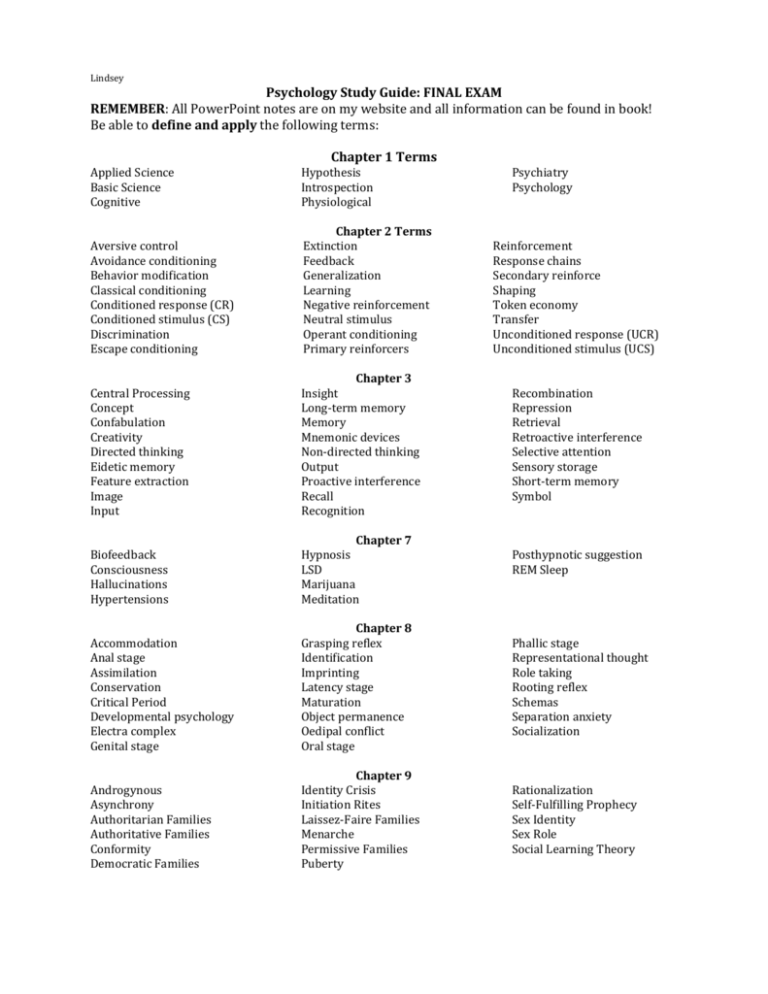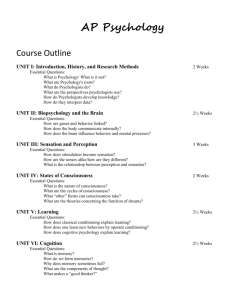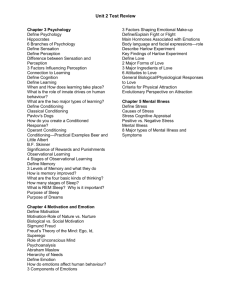Lindsey Psychology Study Guide: FINAL EXAM REMEMBER: All
advertisement

Lindsey Psychology Study Guide: FINAL EXAM REMEMBER: All PowerPoint notes are on my website and all information can be found in book! Be able to define and apply the following terms: Chapter 1 Terms Applied Science Basic Science Cognitive Hypothesis Introspection Physiological Psychiatry Psychology Aversive control Avoidance conditioning Behavior modification Classical conditioning Conditioned response (CR) Conditioned stimulus (CS) Discrimination Escape conditioning Chapter 2 Terms Extinction Feedback Generalization Learning Negative reinforcement Neutral stimulus Operant conditioning Primary reinforcers Central Processing Concept Confabulation Creativity Directed thinking Eidetic memory Feature extraction Image Input Chapter 3 Insight Long-term memory Memory Mnemonic devices Non-directed thinking Output Proactive interference Recall Recognition Biofeedback Consciousness Hallucinations Hypertensions Chapter 7 Hypnosis LSD Marijuana Meditation Accommodation Anal stage Assimilation Conservation Critical Period Developmental psychology Electra complex Genital stage Chapter 8 Grasping reflex Identification Imprinting Latency stage Maturation Object permanence Oedipal conflict Oral stage Phallic stage Representational thought Role taking Rooting reflex Schemas Separation anxiety Socialization Androgynous Asynchrony Authoritarian Families Authoritative Families Conformity Democratic Families Chapter 9 Identity Crisis Initiation Rites Laissez-Faire Families Menarche Permissive Families Puberty Rationalization Self-Fulfilling Prophecy Sex Identity Sex Role Social Learning Theory Reinforcement Response chains Secondary reinforce Shaping Token economy Transfer Unconditioned response (UCR) Unconditioned stimulus (UCS) Recombination Repression Retrieval Retroactive interference Selective attention Sensory storage Short-term memory Symbol Posthypnotic suggestion REM Sleep Ageism Closed awareness Decremental model of aging Generativity Chapter 10 Menopause Mutual pretense awareness Open awareness Stagnation Case study Central tendency Control group Correlation Correlation coefficient Cross-sectional studies Dependent variable Descriptive statistics Chapter 20 Terms Experimental group Frequency distribution Histogram Independent variable Inferential statistics Longitude studies Naturalistic observation Population Why study psychology? Suspected awareness Thanatology Sample Self-fulfilling prophecy Statistics Survey Validity Variable Variance Chapter 1: Introducing Psychology As humans, psychology covers what? 2 ways psychologists believe behavior should be studied What is the scientific method? What are the 4 goals of psychology? What is the difference between basic and applied science? Describe what the 1) following individuals have done to impact psychology and if so, 2) what discipline they are associated with: Copernicus: Wundt: Galton: Galileo: James: Pavlov: Descartes: Freud: Skinner: EGO: SUPEREGO What is dream analysis? What are the following? ID: Based on a scenario, be able to assess and summarize the scenario and choose an approach to draft an explanation of the person’s behavior. Use psychoanalytic, behaviorist, humanist, cognitive, or biological. Study the case study on worksheet “Causes of Behavior: A Case Study” or the scenario from the quiz. For each of the descriptions of the work of psychologists listed below, identify the specialty it describes (Specialties in psychology worksheet) 1. Studies the causes of manic depression 2. Studies the effect of light and dark environments on the visual abilities of kittens. 3. Conducts research on when a child can most effectively learn a second language 4. Studies the emotional changes that occur as a child matures 5. Conducts research on the effect of prejudice on newly-arrived immigrants 6. Designs a more efficient work space for a small company 7. Treats individual who is depressed 8. Presents a program at the local hospital for expectant parents 9. Counsels a couple considering divorce 10. Tests children for learning disabilities Chapter 20: Psychology Research What are the 5 APA Code of Ethics? 1. 2. 3. 4. 5. A theory cannot be accepted until it has been what? A psychologists wants to know how the desire to get into college affects the attitudes of high-school juniors and seniors. What would the psychologists do? What must samples represent? How can a psychologist avoid a biased sample? What would be the correlation between test scores and studying? Why would a researcher choose experimentation over other research methods? What is the difference based on the experiment involving a control group and experimental group regarding variables? **Be able analyze scenarios and identify the independent and dependent variable (Experimental method worksheet) What is necessary in all experiments? **Be able to analyze a scenario (Thinking Drunk, Driving Drunk) and classify certain groups and variables What are examples of naturalistic observation? What is the cardinal rule of naturalistic observation? What is a single-blind experiment? What is a double-blind experiment? Chapter 2: Learning Define and give examples of superstition What is conditioning? What are the 3 basic types of learning? Describe Ivan Pavlov’s experiment with dogs and salivation, the Office with Jim and Dwight. Indicate the UCS, UCR, NS, CS, and CR in each. Pavlov UCS UCR NS CS CR The Office (Can view on YouTube) UCS UCR NS CS CR **Be able to indicate the UCS, UCR, NS, CS, and CR in situations (refer to Classical Conditioning worksheet) What was the outcome of the “Little Baby Albert” experiment? What is the difference between classical conditioning and operant conditioning? **Be able to analyze situations and indicate the spontaneous behavior (sb), stimulus (s), response (r), consequences (c) (refer to Operant Conditioning worksheet) What is the difference between punishment and negative reinforcement? Give an example of modeling: Chapter 3: Memory and Thought What are the 3 steps of information processing? 1. 2. 3. Describe James McConnell’s Molecular Theory regarding RNA and flatworms What psychologists Holistic Theory focused on memories being stored in whole brain? Types of memory What is declarative (explicit) memory? What is Procedural memory? What is sematic memory? What is eidetic memory? What is episodic memory? What is Photographic memory? What is Flashbulb memory? 1. Sensory memory Describe the stages of Memory 2. Short-term memory 3. Long-term memory What is chunking? What is encoding? What is the inference (inhibition) theory? Describe amnesia: What is anterograde and retrograde amnesia? Chapter 7: Altered State of Consciousness Altered state of consciousness involved what? Is sleep an altered state of consciousness? Describe the 4 stages of sleep before entering REM Stage 1 Stage 3 Stage 2 Stage 4 Describe REM sleep in detail: As the night wears on, what do dream become? A large percentage of out dream are what? What are nightmares and why do they occur? What did Sigmund Freud argue about dreams and what they represented? Life Span Unit Chapter 8: Infancy & Childhood What is the one question developmental psychologists seek to answer? When does development begin in an infant? How do psychologists measure capabilities of newborn infants? Piaget spent years observing, questioning, and playing games with babies and young children. What did Piaget conclude? Describe each stage of Jean Piaget’s stages of Cognitive Development Stage 1: Stage 3: Stage 2: Stage.4 Be able to identify each stage (Application of Stages of Cognitive Development worksheet) Emotional Development Goslings, when born, go through a critical period, how many hours after birth is considered the critical period? Describe in detail, Harry Harlow’s experiment with Rhesus monkeys What did Harlow discover later on in life about the monkeys raised without real mother? What occurs around age 3? Human Babies According to one psychologist, children who are separated from their mothers during the early period may never be able to do what? Freud’s Theory of Psychosexual Development Sigmund Freud believed that all children are born with what? In the first few years of life, boys and girls have similar experiences with erotic pleasures through what? What is the major conflict that comes between ages 3-5? Theory of Psychosocial Development What did Erikson believe about childhood experiences? Describe Stages of Psychosocial Development Stage 1: Oral-Sensory: Trust vs. Mistrust Stage 2: Muscular-anal: Autonomy vs. Doubt Stage 3: Locomotor-genital: Initiative vs. Guilt Stage 4: Latency: Industry vs. Inferiority Stage 5: Puberty-adolescence: Identity vs. Role Confusion Describe the 6 stages of Moral Development Stage 1 Stage 3 Stage 2 Stage 6: Young adulthood: Intimacy vs. Isolation Stage 7: Adulthood: Generativity vs. Stagnation Stage 8: Old age: Ego integrity vs. Despair Stage 4 Stage 5 Stage 6 Chapter 9: Altered State of Consciousness What is adolescence? Is adolescence a carefree time to act on ideals unburdened by practical concerns or is adolescence a time of crisis, rebellion, and unhappiness? Your opinion and why? Why do adults feel threatened by youth? Why might adolescents provoke a negative reaction from their parents? Regarding theories of adolescence, what does the following psychologist say? G. Stanley Hall: Margaret Mead: Robert Havighurst: Regarding puberty, what takes place in boys and girls respectively? Erik Erikson’s Theory of the Identity Crisis What are the 4 factors of the identity crisis? 1. 2. 3. 4. Describe 4 Adolescent personality types Identity moratorium adolescents Identity confused adolescents Identity foreclosure adolescents Identity achievement adolescents Is adulthood a time when a person matures fully into what he or she is or is it a time when life closes in and what was once possibility is now limitation? Describe Levinson’s Theory of Male Development? Stage 1: Stage 2: Stage 3: Describe the age-thirty crisis: Describe the empty-nest syndrome List and explain five stages of death and dying 1. 2. 3. 4. 5.






